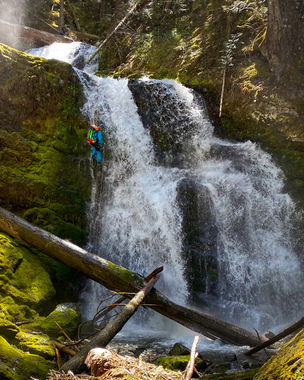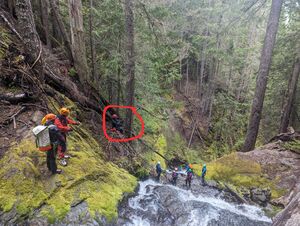Tule Canyon (South Cascades)
| Rating: | |||||||||||||||||||||||||||||||
|---|---|---|---|---|---|---|---|---|---|---|---|---|---|---|---|---|---|---|---|---|---|---|---|---|---|---|---|---|---|---|---|
| | Raps:11 + 1 jump, max ↨130ft
Red Tape:No permit required Shuttle:None Vehicle:High Clearance | ||||||||||||||||||||||||||||||
| Start: | |||||||||||||||||||||||||||||||
| Parking: | |||||||||||||||||||||||||||||||
| Condition Reports: | 24 May 2025
"A scenic canyon with chill vibes at moderate-low flow. At least four raps can be bypassed with down climbing. J1 pool was too low to jump, but did pre |
||||||||||||||||||||||||||||||
| Best season: | May-July
|
||||||||||||||||||||||||||||||
| Regions: | |||||||||||||||||||||||||||||||
Introduction[edit]
Tule Creek is a good option for canyoneers looking for an early season canyon (particularly during the spring melt months). It likely dries up in mid to late summer. The canyon offers numerous rappels and even a small jump. There are two two-tiered larger rappels that are memorable. The majority of anchors are natural anchors so canyoneers looking to enter Tule Creek for the first time of each year should bring ample webbing.
The canyon is not particularly committing and there are various points on the left and right side that could be used as potential escape routes. The canyon has a drainage of 1mi^2 but some rappels can still pack a punch if you rappel directly in the flow where the water channels are.
Approach[edit]
Follow the East Canyon Ridge Trail #265 until it reaches the closest point to the creek (about 3300 ft). Bushwhack down to the creek and suit up near the creek.
Descent[edit]
DCL: Down Canyon Left; DCR: Down Canyon Right
R1: 30’ from webbing around a log in the center of the creek
R2: 45’ from single bolt station in the center of the creek
R3: 25’ from single bolt DCR (nuisance low angle rappel)
R4: 40’ from webbing around a log (nuisance low angle rappel)
R5: 20’ DCR from webbing around a log
R6a: 130’ DCR from webbing around a log. This is a two-tiered rappel. Watch for sharp edges atop the second tier. If using R6b this is a 50' rap down to the wide tier where the team can transition to the rappel line coming down from R6b.
R6b: 80' DCL from webbing on tree. This is an alternate anchor that bypasses the first tier and reduces the chance of rope abrasion over the edge of the next tier. Not recommended to have the full team rappel from here due to damaging the hillside. Use R6a anchor or other for first pitch and have one person rig the second tier from this R6b location and drop the rope to the team. Only one person needs to man the station and can then complete the rappel from there. Other team members will get on the rope from below.
R7: 50’ from webbing around a log
J1: 8’ jump / rappel / handline. (Debris/gravel/rocks have largely filled the pool as of 5/25. Very technical / shallow jump. Scout, and prepare for meat-anchor + down-climb/stemming by tall team member.
R8: 10’ around a log
R9: 10’ around a log
R10: 100’ from webbing around a log. This is a two-tiered rappel. A 200ft rope will reach for rap and pull. Depending on flow, move the webbing to choose your preferred line.
R11: 30' rap from any log above the pitch or downclimb.
Exit[edit]
The creek flattens shortly after R11 to river gravels. Leave the creek DCR and walk through easy brush back to your car.
Red tape[edit]
None.
Beta sites[edit]
Media[edit]
Background[edit]
This canyon was first descended May 15th, 2021 by Ryan Ernst, Jake Huddleston, Haruka Clay-Lipscomb, Mike Peterson, Barry Specht, and Tiffanie Lin. Tule was a backup canyon as our first objective was running much too high -- it ain't easy running canyons during Spring melt!
Trip reports and media[edit]
Background[edit]
Tule is correctly pronounced "two-lee". From Columbia River Gorge National Fish Hatchery Complex's Education Specialist, Cheri Anderson, the word Tule has two opposing meanings: 1) Tule is derived from "Mitula", a native American word meaning light flesh or white salmon; and 2) the opposing meaning is opposite of light - the word tule translates to dark. Tule Fall Chinook salmon's interior meat turns very light while their exterior turn very dark when they return from the ocean in the fall to spawn. Also, Tule elk on the Pacific coast are much darker colored than other elk.

